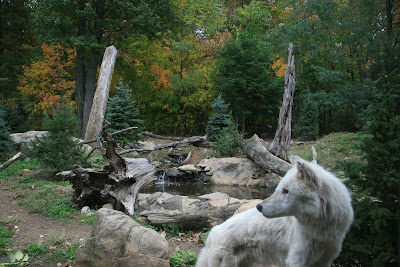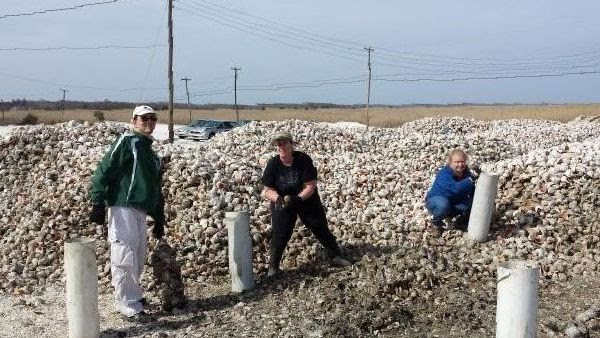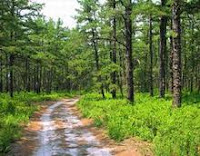The latest Discover DEP podcast takes a look at how the bald eagle has successfully recovered in the Garden State from the impact of DDT as well as insightful information on this majestic bird's habits, habitats, and life cycle.
This episode can be found at www.nj.gov/dep/podcast/ on the NJDEP website.
For more information on eagles in New Jersey, please visit njfishandwildlife.com/ensp/raptor_info.htm#eagle on the Division of Fish and Wildlife website.
Monday, January 30, 2017
Wednesday, January 25, 2017
New Jersey Bald Eagle Population Thriving
 | |||
| A bald eagle at Mountain Lakes Preserve, Princeton, NJ - Photo by Christina Keddie CC BY-SA 4.0 via Wikimedia Commons |
The 2016 Bald Eagle Project annual report has been released and is available on the NJDEP Division of Fish and Wildlife website.
The Bald Eagle population continues to thrive with 172 nest sites monitored (150 documented with eggs) which is up by 11. A total of 216 new birds were born to 132 of those nests.
These numbers are more than what's needed to help maintain the state's current bald eagle population.
In the 1970s, the eagle was pushed to the brink in New Jersey and its recovery has been perhaps the greatest success of the endangered species program in the state. No longer listed as endangered in NJ, we were reduced to just one nesting pair in 1973 in a Cumberland County forest.
The biggest threats to the bald eagle population are still habitat loss and human activity that can change eagles' behavior. Though contaminants in the birds' food web can still affect nesting, that threat has been reduced in the past four decades due to the banning of dangerous chemicals in pesticides.
New Jersey's bald eagles are monitored throughout the nesting season in order to protect them and their nests. GPS transmitters are attached when possible to young eagles to follow their movements.
The Delaware Bay region has the largest eagle population. 47 percent of all nests are in Cumberland and Salem counties and on the bay side of Cape May County. But 15 new eagle pairs were seen this season. There were a dozen in south Jersey and three in the central part of the state.
For the full report visit njfishandwildlife.com/ensp/raptor_info.htm#eagle
Wednesday, January 18, 2017
Seeing Wolves in New Jersey
 |
Wolf Woods habitat at Turtle back Zoo in Essex County - via state.nj.us/gspt/photo_gallery.htm |
Wolves can be found in North America, Europe, and Asia. Expanding development, farming, and ranching activity has drastically reduced the wolf’s range and population. Suitable habitat now restricts wolves to remote areas of their traditional range.
But conservation and education efforts will hopefully protect and preserve wolves throughout the world. There are no wolves in the wild in NJ, but you can visit them in captivity.
Reintroduction programs are being implemented and captive wolves in zoos, and wolf research centers are being maintained to insure that the genetic purity of wolf species is preserved. Turtle Back Zoo’s wolves come from Wolf Park Research Center in Battle Ground, Indiana.
In the urban wilderness of Essex County, you can visit wolves at the Turtleback Zoo which has a Wolf Woods habitat. You can see timber wolves close up but safely through glass panels that let you feel like a member of the pack. Several viewing stations let you see the wolves from different angles. You will wolves see crossing a stream, resting on logs and rocky outcroppings and nose-close right at the window. The Zoo is located at 560 Northfield Avenue, West Orange, New Jersey.
If you want to hear the howling of wolves in NJ, you can also head to the mountains of the Delaware Water Gap in Warren County, NJ. At the Lakota Wolf Preserve, there are great photo opportunities with packs of Tundra, Timber, and Arctic wolves in a natural surrounding. There are also bobcats and foxes at the reserve. The preserve is at at 89 Mt. Pleasant Road, Columbia, NJ - see http://www.lakotawolf.com/ for information.
Friday, January 13, 2017
Further Preservation at the Paterson Great Falls Historical Park
The Department of Environmental Protection announced this week that the Green Acres Program has purchased a tract of land near the Paterson Great Falls National Historical Park to preserve the viewshed and support visitation to this important landmark.
The 8.5-acre site sits upon a dramatic ridge that rises more than 100 feet above the Passaic River, and offers an excellent view of Paterson’s Historic District below and the New York City skyline in the distance.
The property is adjacent to Paterson Great Falls National Historical Park; partially within the National Historic Landmark district, and adjacent to the Great Falls of Paterson-Garret Mountain National Natural Monument. Preservation of this property provides the opportunity for an expanded trail system, historic interpretation and other park amenities.
“Preserving this land is very important to enhancing the Paterson Great Falls Historical Park and preserving another aspect of the site’s important heritage,” DEP Commissioner Martin said. “The preservation of this beautiful landscape would not be possible if not for the shared vision of all the partners in this project and their commitment to preservation of this land. The Christie Administration remains committed to preserving historic sites that are important to people in the state and in cities like Paterson.”
“The site offers the possibility of creating a sequence of overlooks, landscapes, pathways and features that bring together the richness of a spectacular natural history and ecology; an aspect of our industrial and Native American heritage, and current day community and tourist interests, including recreation, interaction and events,” said Paterson Mayor Jose “Joey” Torres. “We envision a design strategy that will work to amplify existing assets and will enhance the natural beauty of the site.”
The Green Acres Program purchased the property from Paterson Renewal Associates, LLC for $5.7 million. The land, once slated for a housing development, contains a parking lot that will be used to support public access.
DEP will partner with the City of Paterson regarding improvements to and management of the property.
“We’re very pleased that this parcel is going to be preserved as open space,” said Kate Marcopul, Administrator of the State’s Historic Preservation Office (SHPO). “This action will preserve the integrity of the setting and the character of Paterson’s nationally significant historic sites, so that current and future generations of New Jerseyans can better understand its importance to our history.”
The Falls area has a long and storied history linked closely with not only the beginning of the United States but with a number of the key people who made the new nation a reality. In 1778, Alexander Hamilton first visited the Falls and was impressed by its potential for industry. Later, after Hamilton took the position as the nation’s first Secretary of Treasury, he selected the area as the site of the nation’s first planned industrial city, which he called a “national manufactory.”
In 1791, Secretary Hamilton helped found the Society for the Establishment of Useful Manufactures (S.U.M.), a state-chartered private corporation to fulfill this vision. Paterson itself was founded by the Society that same year and it chose to name the new town after New Jersey Governor William Paterson – a signer of the Constitution and, later, an Associate Justice of the United States Supreme Court – in appreciation of his efforts to promote the society.
“Preserving this property is a win for New Jersey for both ecological and historic reasons,” said Rich Boornazian, Assistant Commissioner of Natural and Historic Resources. “New Jerseyans and visitors to our state will now have additional space to see this geologic marvel and to further learn how it inspired leaders to build Paterson and a new industrial foundation for a young nation.”
The Green Acres Program, with help from public and private partners, has directly protected more than 680,000 acres of open space and provided hundreds of recreational opportunities for a variety of activities, including natural areas, hiking and fishing areas, city parks, playgrounds, athletic fields, boat ramps, docks, fishing piers and environmental education.
For more information on the DEP’s Green Acres Program, please visit: nj.gov/dep/greenacres/
Wednesday, January 11, 2017
Peregrine Falcon Annual Report for 2016
The 2016 Peregrine Falcon research and management report is available on the NJDEP Division of Fish and Wildlife.
The population remained relatively stable with 35 known pairs (30 active) occupying suitable nesting habitat across the state.
For the full report visit njfishandwildlife.com/ensp/raptor_info.htm#peregrine
Tuesday, January 10, 2017
2016 Annual Report from the NJDEP Division of Fish and Wildlife
The 2016 Annual Report from the NJDEP Division of Fish and Wildlife is available on the Division's website.
The report contains an overview of each Division bureau or office along with highlights from the year.
The report, along with prior years' reports, can be viewed at njfishandwildlife.com/about.htm .
The report contains an overview of each Division bureau or office along with highlights from the year.
The report, along with prior years' reports, can be viewed at njfishandwildlife.com/about.htm .
Monday, January 9, 2017
American Littoral Society Seeks Volunteers
CALL FOR VOLUNTEERS
TO HELP MAKE SHELL BAGS

Saturdays, Jan. 28, Feb. 25 & Mar. 25
10 a.m. - 2 p.m.
8779 Berry Ave,
Port Norris, NJ
Google maps: https://goo.gl/maps/
Foul weather dates: Sundays Jan. 29, Feb. 26 & Mar. 26
The American Littoral Society needs your help to bag shell for two new intertidal reefs to be built in the Delaware Bay this spring. We have the materials in place, but need some helping hands to fill the bags.
The bagged shell will be used at one of the horseshoe crab beach restoration projects along the Delaware Bay. Reefs off those beaches provide calmer waters for horseshoe crab spawning, as well as habitat for juvenile fish and invertebrate species.
The work will take place on the docks of the Maurice River. It will involve cutting and tying bags, filling mesh bags with shells, and stacking the bags. The shell bags will weigh approximately 20 pounds each. The task will be dirty and a bit smelly, so be sure to dress appropriately.
Lunch will be provided for all volunteers.
For more information, please contact Quinn Whitesall at Quinn@littoralsociety.org or (856) 825-2174.
Quinn will also be bagging shell on the following Tuesdays, Wednesdays, and Thursdays (Lunch not provided):
January 24-26
February 1, 2, 7-9, 21-23, 28
March 1, 2, 14-16, 21-23
Bagging will be weather dependent, so please contact Quinn if you plan on attending any of the weekday bagging days.
|
Sunday, January 8, 2017
Running the Long Path: A 350-Mile Journey of Discovery
January 14, 2017 at 1 pm
Running the Long Path:a 350-Mile Journey of Discovery in New York's Hudson Valley
at the Catskill Interpretive Center, Mt. Tremper, NY.
Join Ken Posner for a talk on New York's greatest trail, the 358-mile Long Path which stretches from New York City all the way to Thacher State Park outside Albany, along the way crossing through some of the Hudson Valley's most magical spots including the Palisades, Harriman, Shawangunks, Catskills, and the Schoharie Valley.
The presentation will feature the history of the Long Path, including the voice of historical figures like Walt Whitman and John Burroughs, landscape images by award-winning photographer Steve Aaron, discussion of planning and gear, and some of Ken's adventures during his 2013 record-setting thru-run of the trail.
Saturday, January 7, 2017
Public Meeting About South Jersey Gas Pipeline Project in the Pinelands
January 24, 2017
9:30 am
New Location: Parish Centre, St. Ann's Catholic Church
22 Trenton Road, Browns Mills NJ 08015
Former location was Ocean Acres Community Center in Manahawkin.
Friday, January 6, 2017
Family-Friendly Outdoor Activities at HPSP
 |
| High Point Monument |
The 15,413-acre High Point State Park is well-regarded for its hiking and skiing trails, as well as locations for camping, fishing and numerous other activities.
Established in 1923 in the state’s Skylands Region, the park also is home to the High Point Monument, the highest point in New Jersey. High Point is the highest elevation in the state at 1,803 feet (550 m).
High Point is the highest peak of the Kittatinny Mountains. Three states – New Jersey, New York, and Pennsylvania – can be seen from the top.
At the peak is the High Point Monument, a 220-foot (67 m) obelisk, built in 1930 as a war memorial. From the monument, there is a spectacular panorama of hills, valleys, lush farmland and more in the 3 states.
High Point is the site for some activities this month for adults and children. Ranging from storytelling, games and crafts focused on nature during wintertime, to outdoor exploration and trail walks at the park.
Many people stay indoors more in winter, but it can be a great time to get out, explore nature, and enjoy the scenery at our state parks and forests.
To learn more about the programs below or to register, email register.highpointprograms@gmail.com or call (973) 875-1471.
January 7, 14, 21 and 28, 10:30 a.m. to noon
Nature in Winter Walk: A guide and participants will look for tracks and signs of wintering wildlife, as well as dormant trees, plants, insects and more. A limited number of snowshoes in child and adult sizes are available, and must be reserved by 4 p.m. the Friday before each walk. Use of snowshoes will be weather-dependent. Reservations are required and locations vary. Ages 7 and up.
Fee: $2 per person for the walk, $5 per person to borrow snowshoes
January 12 and 26, 1 p.m. to 2 p.m.
January 13 and 27, 10:30 a.m. to 11:30 a.m.
Fledgling Naturalists: Children’s curiosity will be encouraged through hands-on outdoor activities involving stories, games and crafts. For children ages 3 to 5, with an adult partner. Each adult may bring a maximum of two children, not including infants. Children or siblings over age 5 may not attend. Registration is required by 4 p.m. the day before the program.
Fee: $5 per adult/child pair, $2 for additional children ages 3 to 5.
January 13, 1:30 p.m. to 3:30 p.m.
Homeschool Naturalists: Hands-on activities will give homeschooled children an opportunity to explore the natural world and interact with peers. Suggestions for additional study and resources will be provided. Registration is required by noon the day before the program. For children ages 6 to 10 in grades 1-5 with some ability to read and write.
Fee: $5 per child (must be accompanied by an adult)
January 14, 2 p.m. to 3 p.m.
Snow and Ice: Games, crafts and experiments will be utilized to teach families about snow, ice and winter weather. A guide will explain how park wildlife survives frozen temperatures, and participants will be able to cut their own snowflakes. The free program is both indoors and outdoors. Ages 6 and up.
To learn more about High Point State Park, visit: www.nj.gov/dep/parksandforests/parks/highpoint.html
Monday, January 2, 2017
Guided Walks at Higbee Beach
| Higbee Beach via capemaybeach.com/higbeebeach.html |
Guided walks in the Hidden Valley area of Higbee Beach WMA are being offered monthly by NJ Audubon in cooperation with the NJDEP Division of Fish and Wildlife.
The Higbee Beach Wildlife Management Area is important for its value to endangered, threatened and nongame wildlife.
This Cape May peninsula hosts one of the world's largest migrations each fall as millions of birds stop at the peninsula seeking food, cover and water. Higbee Beach plays a vital role in the migration, providing migrants with a stopover site as they increase their fitness before continuing their sojourn south.
The roughly 1,100-acre area offers a unique blend of several different habitats, including dune, forest, scrub-shrub and early successional fields. The Endangered and Nongame Species Program, in cooperation with the Bureau of Land Management, manages the fields and scrub-shrub areas for migrating songbirds and raptors.
There are two new viewing platforms that have been added to the nearly 2 miles of nature trails at the area. The platforms, which offer spectacular views of the field and forest canopy, feature educational signs on migration and habitat.
A a new dune trail which runs through forested dunes with views of the expansive Delaware Bay was added in 1999.
Higbee Beach is comprised of six different locales: Signal Hill, Davey’s (or Davis) Lake, Pond Creek, Sassafras Island, Hidden Valley, and the Magnesite Plant.
Hidden Valley's mix of varied habitats hosts a diversity of birds which may be encountered, including sparrows, hawks, waterbirds, and even the possibility of an owl.
According to capemay.com, Hidden Valley was once a 92-acre farm between Bayshore Road and the Pond Creek Marsh. The Dickinson family, preferring it be preserved rather than developed, sold it to the state in 1986. Part of the acreage is known as Hidden Valley Ranch, and is leased for equestrian activities. The fields, trails and swamps are well known to birders.
The next scheduled walk is Sunday, January 8 at 4:00 p.m.
For more information visit community.njaudubon.org
If visiting during the fall migration, it is suggested that you go following a cold front with northerly winds. All you need is a set of binoculars and ID books.
In warmer weather, Higbee Beach is also home to lots of dragonflies and butterflies, including the long-distance migrant - the Monarch butterfly.
Subscribe to:
Posts (Atom)



